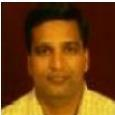
J. S. Chitode
Work place: Dept. of Electronics BVUCOE Pune, India
E-mail: j.chitode@gmail.com
Website:
Research Interests: Speech Synthesis, Speech Recognition, Natural Language Processing
Biography
Dr. J. S. Chitode is a professor received the B.E. degreein Industrial Electronics Engineering from Bharati Vidyapeeth University, Pune, Maharashtra, india in 1991. He received M.E. degree from College of Engineering (COEP), Pune at University of Pune from Maharashtra, India in 1995. He has received Ph.D. degree in Electronics from Bharati Vidyapeeth Deemed University, India in 2009. Currently he is a professor in the Bharati Vidyapeeth Deemed University College of Engineering, Pune (India). His research interest includes Signal processing, Speech Synthesis, Digital Communication, etc. Dr. Chitode is actively participating as a member of different professional research societies, like IEEE, ISTE, etc.
Author Articles
Least Significant Bit and Discrete Wavelet Transform Algorithm Realization for Image Steganography Employing FPGA
By Kalpana Sanjay Shete Mangal Patil J. S. Chitode
DOI: https://doi.org/10.5815/ijigsp.2016.06.06, Pub. Date: 8 Jun. 2016
Steganography is the science that deals with conveying secret information by embedding into the cover object invisibly. In steganography, only the authorized party is aware of the existence of the hidden message to achieve secret communication. The image file is mostly used cover medium amongst various digital files such as image, text, audio and video. The proposed idea of this research work is to develop the robust image steganography. It is implemented using Least Significant Bit and Discrete Wavelet Transform techniques for digital image signal to improve the robustness & evaluate the performance of these algorithms. The parameters such as mean square error (MSE), bit error rate (BER), peak signal to noise ratio (PSNR) and processing time are considered here to evaluate the performance of the proposed work. In the proposed system, PSNR and MSE value ranges from 42 to 46 dB and 1.5 to 3.5 for LSB method respectively. For DWT method these results are further improved as it gives higher PSNR values between 49 to 57 dB and lower MSE values 0.2 to 0.7.
[...] Read more.Other Articles
Subscribe to receive issue release notifications and newsletters from MECS Press journals